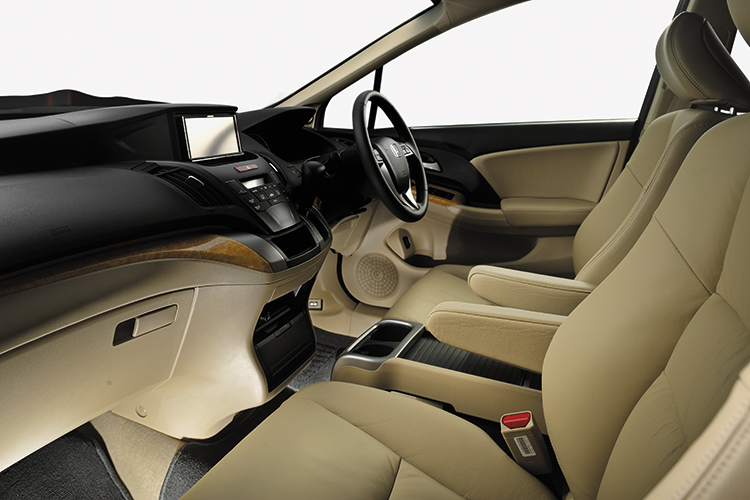
Few people “want” a multi-purpose vehicle (MPV) since these cars are neither flashy nor sporty, and hardly exude any level of desirability.
Most of all, they lack “cool”.
So, in the end, you would buy one because you really need an MPV for one big reason: seating capacity.
Honda recognised that a van-like proportion was the main reason MPVs earned their staid image, and figured that there is a market for a sleek seven-seater.
The boxy Odyssey was, therefore, re-designed to have a lower floor, the cabin pushed forward and overall height drastically reduced.
The 2003 model received the thumbs-up from the motoring press and motorists alike.

There’s plenty of room for its work as a people-mover.
Even though it looked a mile long, it was some 30mm shorter than the contemporary Honda Accord and a mere 15mm longer than its van-like predecessor.
After five successful years, the Odyssey gets a major revamp.
The new “car” continues with the basic styling theme of being low and sleek, and is instantly recognisable as an Odyssey.
There are obvious detailed changes, though: Its new face carries a heavily sculptured grille and a front bumper that bears a strong resemblance to the FCX Clarity’s.
Group Test: Toyota Vellfire 2.5 versus Honda Odyssey 2.4 versus Nissan Elgrand 2.5
Those horizontal headlights are slightly slimmer now and give the Odyssey its own unique character, unlike the vertically stacked design so typical of MPVs.
If there was one aspect of the previous Odyssey that lacked aesthetic appeal, it was the bland tailgate design with the huge blank space between the tail lights.

On the new car, the plate sits just below the rear window, flanked by horizontal light clusters.
It is a more cohesive design, for sure.
But, in the process, it even looks more conventional now.
The big changes lie under the skin.
And as subtle as they seem, they are both evolutionary and technically progressive.
The engine is a modified version of the old 2.4-litre single cam and is now a “proper” VTEC (with the extra high cam).

Odyssey’s mix of digital and analogue for the instrument panel looks good.
Even though it develops the same 218Nm of torque (at the same 4500rpm), its ability to rev 1000rpm more gives the engine an additional 20bhp at a higher engine speed (180bhp at 6500rpm versus 160bhp at 5500rpm).
Honestly, the additional 20bhp isn’t that obvious unless you really stretch it.
In the usual stop-start drive around town, it feels very similar to the old car and requires quite a heavy right foot to get this near 1.7-tonne vehicle going briskly.
Fortunately, the engine is smooth and eager.
Beyond 4500rpm, there is a more aggressive tone.
And acceleration does not wane till around 6000rpm. (In the old car, the engine runs out of breath at 5000rpm.)

The five-speed automatic transmission has been tweaked to lock up at lower speeds in the interest of fuel efficiency, but there is no longer a manual sequential function.
Quite unfortunate, because with sequential shift, you could choose the best gear for the moment – particularly in urban driving, where you could prevent unnecessary upshifts.
Apparently, most Odyssey owners left the lever in “D”, so the feature was dropped on the new model.
The suspension system has been fettled to provide a more comfortable ride.
Towards this end, the spring rates for both front and rear have been reduced.
Yes, the ride is noticeably more compliant, but you’ll be wrong to assume that the new car is soft and floaty.

Even with the new electric power steering (previously hydraulic), the Odyssey steers and handles with so much dexterity that it keeps its crown as the best-handling MPV.
Spring, damping and anti-roll characteristics are spot-on, and we doubt that aftermarket suspension kits that lower the Odyssey and stiffen its suspension can improve on the brilliant factory standard.
Inside, there is an additional 60mm of space and the driver sits a little closer to the dashboard.
So, accessing the radio and air-con controls (and the IU) are no longer a stretch, while slimmer A-pillars make a huge difference in reducing blind spots.
There is enough legroom in the middle to slide the centre row forward, to donate some extra space to the occupants of the third row.
Ingress to the rear has also been improved by re-profiling the rear-door opening – like the boot, which now has a wider opening.

Odyssey third-row seats fold at a touch of a button.
But the actual capacity remains unchanged.
The automatic climate control has separate temperature controls for three separate zones.
Not that it makes a huge difference, but it’s just one of those non-essential convenience features that carries a huge dose of showroom appeal.
It works well, but so did the single-zone affair in the previous model.

Come to think of it, most of the previous Odyssey worked very well.
So what is this new one all about?
Well, as we mentioned, it is a subtle technical evolution that has brought about more refinement, more space and better dynamics that, ultimately, made a good MPV even better.
2008 Honda Odyssey 2.4 (A)
DRIVETRAIN
Type Inline-4, 16-valves
Capacity 2354cc
Bore x stroke 87mm x 99mm
Compression ratio 10.5:1
Max power 178hp at 6500rpm
Max torque 218Nm at 4500rpm
Power to weight 106hp per tonne
Gearbox 5-speed automatic
Driven wheels Front
PERFORMANCE
0-100km/h 11.5 seconds
Top speed 209km/h
Consumption 12km/L (combined)
SUSPENSION
Front Double wishbones, coil springs, anti-roll bar
Rear Double wishbones, coil springs, anti-roll bar
BRAKES
Front / Rear Ventilated discs / Discs
TYRES
Type Yokohama Aspec
Size 215/55 R17
SAFETY
Airbags 6
Traction aids ABS, VSA
MEASUREMENTS
Length 4800mm
Width 1800mm
Height 1545mm
Wheelbase 2830mm
Kerb weight 1680kg
Turning circle 10.8m
BUYING IT
Price incl. COE $95,600
Warranty 3 years/100,000km
+ Refinement, handling, cabin comfort
– Not enough power, no manual mode on auto box, colour of the “wood” veneers












